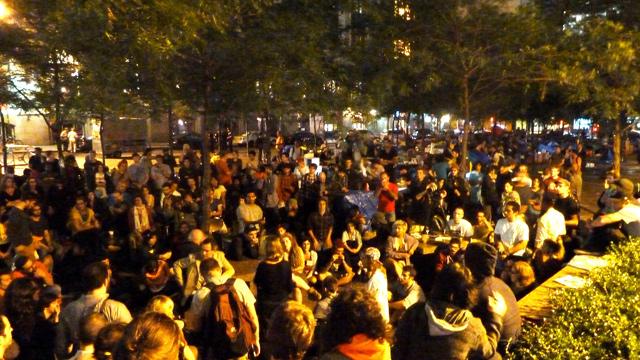
What is a General Assembly? We have all seen the pictures of masses gathered at the park, but what were they doing? And, more importantly, will these gatherings continue?
The General Assembly is the decision-making model for the Occupy Movement, employing consensus decision-making, a process that demands a high level of agreement on a proposal and is extremely participatory. Members of the movement attend the assembly to ask questions and decide on the proposals on that night’s agenda. This high level of participation in the assembly makes Occupy a directly democratic movement.
Participation is the key to political empowerment. Americans see politics as a game played by professionals, but by creating a totally public political space in a park, Occupy is de-professionalizing the political class and returning power to the citizenry.
On April 14, Occupy Wall Street will stage Spring Awakening 2012: Occupy Wall Street Peoples Assembly, which will serve as a coordinating body for all New York occupiers. OWS’s revolutionary analysis has broken New York out of its issue silos, and now we can coordinate together to undertake our generation’s ultimate challenge: dismantling unregulated capitalism to save our society and our planet.
Though we're primarily concerned with the economic, social and environmental woes that could dim our future, the General Assembly takes its cues from our nation’s founding history. After the Boston Tea Party, the most famous episode of property destruction in American history, the British monarch moved immediately to abolish the town hall meeting, which quickly became a forum for organizing the American Revolution. Militias were organized in town hall meetings and committees of correspondence, which coordinated responses to Great Britain and shared plans, sprang up throughout the colonies. Had these democratic institutions not been in existence, the already ragged Revolutionary Army would have been doomed.
Hannah Arendt’s On Revolution beautifully presents the struggle between representative democracy and direct democracy in America. She writes of Shays’ Rebellion in 1787 in way that clearly shows the continuing animosity between the town council and the federal government: The rebellion was planned in a town council by a group of local farmers striking back at a foreclosure and debt crisis brought on by a once-direct—now suddenly representative—democracy. Thomas Jefferson, upon hearing this news from abroad, wrote: “The tree of liberty must be refreshed from time to time with the blood of patriots and tyrants. It is its natural manure.”
The writing of the Constitution and the extreme power given to the Senate and the House marked the end of the directly democratic nature of America. Not only was democratic participation now firmly confined to the ballot box, but even more terrifying was the loss of the American Revolutionary spirit. Jefferson did not see revolution as some sort of horrible specter of violence, but a rebuilding of government institutions to better suit generations to come.
All this talk of town hall meetings reminds Americans of libertarianism, a dirty word to the left. The American history of libertarianism has been claimed by the American Right. Make no mistake: This is a historical battle ground: The Right will constantly claim the mantle of the Revolutionary War and white supremacists will also claim the revolutionary narrative as they fight off federal regulations, just as the majority conservative wing of the Supreme Court claims to hold true to the founding myth as they defend the rights of corporations nationwide.
We must reclaim this word by first admitting to ourselves that these American institutions were built on the backs of women, African slaves and Indigenous peoples. Fully understanding this history is no small task and it will take generations of anti-oppression education to undo a half-century of indoctrination. But the benefit is that an anti-racist, anti-sexist understanding of libertarianism would shine a light on the bigotry at the core of the Right and create a new libertarian agenda based on non-hierarchy and social equality.
Had the police forces of the United States looked closer into the parks they so violently raided nationwide they might have seen this lost American history playing itself out day by day. They might have felt the lost revolutionary spirit spoken of so fondly by Mr. Jefferson.
One might ask how OWS claims to be a direct democracy with seemingly little to no actual power to wield in its decision-making. This is not a testament to the weakness of OWS, but to the limited nature of American representative democracy. Representative democracy has been perverted by the 1%, so that even at the only point of participation, the ballot box, its citizenry is keenly aware that their vote doesn’t count. Our votes are meaningless not because we are only one in 311 million Americans but because of the billions of dollars funneled into the legislative system that claims to represent us. The use of direct democracy by OWS is a battle cry against this corrupt system, a picture of a new world crying out: “There is another way!”
Occupy Wall Street has brought direct democracy back to America. In New York alone there are 14 neighborhood assemblies—nearly three in every borough. Our direct democratic structures will be ready this time to receive the oppressed, the lost and weary, violently tossed out by a system built on their backs.
Proudly continuing our American tradition, we join together as a direct democratic body, not due to efficiency or ideology, but because we seek to be a reflection of the world we want to create. Each citizen present on April 14—and May 1—will harness their own power and wield it to solve issues for themselves, because direct democracy never would have allowed for the current state of American politics—and it may well be the solution.
3 WAYS TO SHOW YOUR SUPPORT
- Log in to post comments














